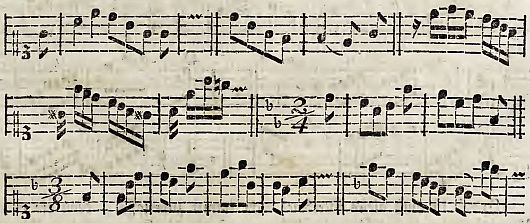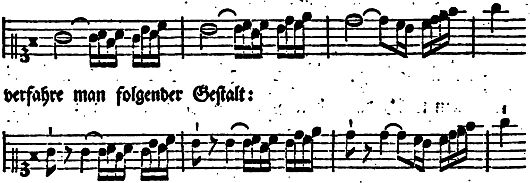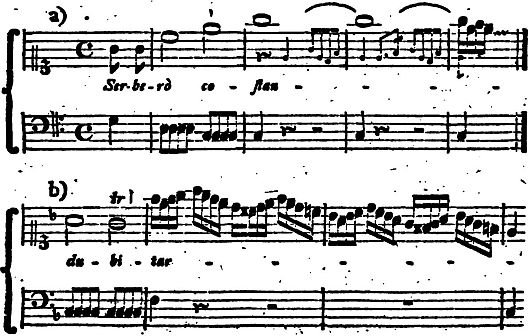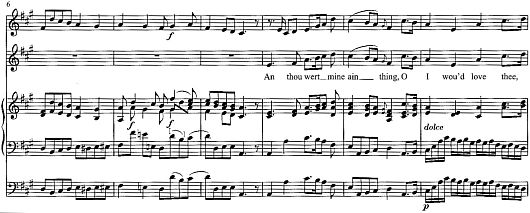From Phrase to Phrasing
A Classical Perspective
Chapter 5 – Notation and Performance
Whereas in language there is an age-old system of punctuation marks, in music we only have implied notation through cadences. But there have been instances where composers felt the need to indicate phrases explicitly, inventing their own symbols.
Symbols
François Couperin (1668-1733) kept a direct link with language, using a comma to mark the end of melodies or harmonic phrases. He explains ‘the separation should be almost imperceptible, but its absence would make persons with taste feel that something in the performance is missing—it is like the difference between those that read everything through and those who make stops at commas and periods.’42Couperin, Troisième livre de pièces de clavecin, first edition (Paris), preface.

Figure 60: Couperin: Le Carillon de Cithére from the Third book of harpsichord pieces, first edition (1724).
Michel Blavet (1700-1768), in his Flute Sonatas op.2 (1732), uses a small h (for haleine, breath) to indicate places to breathe. A breath mark is not the same as a phrase indication but as he writes in his preface: ‘I have often noticed with students that as a consequence of difficulties in catching one's breath, they mix up one phrase with another, or interrupt a melody that should pass in one breath. To prevent this confusion I have put the letter h on the spots where one should take a breath; above all in melodious pieces ... where all charm depends on the arrangement of phrases.’

Figure 61: Blavet: from La Vibray, op.2,2 (1732).
In works with an educational purpose I have found various symbols for breath marks like ꞌ or * or = or ; or ^.
In some composition treatises we find symbols indicating phrase structures. Riepel uses ■ for a tonic phrase-ending (Grundabsatz), and □ for all other phrase-endings (Änderungsabsatz).43Joseph Riepel, Anfangsgründe zur musicalischen Setzkunst: Grundregeln zur Tonordnung insgemein, 7 vols (1755), ii, 41. Koch copied Riepel’s □ as a general symbol for phrase endings, and added Δ to indicate phrase-parts.44Heinrich Christoph Koch, Versuch einer Anleitung zur Komposition, 3 vols (Leipzig, 1787), ii, 361.
Türk is, as far as I know, the first to propose a dedicated new symbol to mark repose-moments in a composition.45Türk, Klavierschule, oder Anweisung zum Klavierspielen für Lehrer und Lernende, 342.
He calls this // an Einschnitt (incision), adding to the confusion whether a term relates to the phrase-part itself (in German often called an Einschnitt) or to the point of separation. Türk places his symbol on the last note of the phrase and not between phrases, thus giving it the appearance of an articulation mark. He invites other composers to follow his lead and counters expected criticism: ‘to everyone who claims it is unnecessary to indicate phrases in music, I ask why we have introduced it in writing and still use it even in books aimed at learned people.’
But even if the composer goes as far as to indicate the phrases, there is still the performer who, as a unique musical individual, has to give shape to his or her understanding of the music. This personal aspect it too specific for the treatises; usually they only mention that good phrasing is essential and can be developed by listening to good performers, especially singers. Good advice as this may be, it is impossible to bring those performances back to life, and we have too little knowledge of the actual use of the voice to make present-day singing a reference.
On the other hand, authors have written about what you could call ‘skills’ related to phrasing. Türk, for instance, describes separating two phrases by lifting the finger off the key, causing ‘a little pause which should come in the time of the last note of a phrase. The end of the phrase will be even more noticeable if you lift the finger softly from the key, and mark the first tone of the next phrase a bit stronger again’.46Daniel Gottlob Türk, Klavierschule, oder Anweisung zum Klavierspielen für Lehrer und Lernende (Leipzig und Halle, 1789), 341. In Fig. 63 an example in notation:

Figure 63: Examples by Türk: (A) as notated, (B) as played, (C) added by me according to Türk’s text.
I would like to classify these notations as:
- (a) implicit
- a notation where we have to deduce the phrase-ending from the strength of the cadence.
- (b) implied
- a notation where the phrase-ending is implied from how the end of a phrase is supposed to sound—softer and shortened.
- (c) explicit
- a notation that indicates where the phrase-ending is.
In essence the three notations are identical, except for the degree that the composer draws your attention to the phrase-ending. I want to stress that notation (a) does not prohibit any pause or tapering off of the phrase. The fact that the phrase-ending is not explicitly written out, or implied by notation, does not change the fact that it is needed there: the phrase structure demands it.
Türk further explains the amount of finger lifting is determined by context: separation between periods needs to be bigger than between phrases, and those require more again than between phrase-members. Phrases in the same character need less separation than phrases of a completely different character.47Daniel Gottlob Türk, Klavierschule, oder Anweisung zum Klavierspielen für Lehrer und Lernende (Leipzig und Halle, 1789), 342. Therefore implied notation is not to be taken literally; the crucial thing is that the final note is shortened and softer, not that it is exactly half the value, nor that it is only one written degree softer. In other words, punctuation is the guide, not the notation.
Since smaller repose-moments need a more delicate sensitivity to detect, the more ‘meticulous’ (Türk) composers show phrase-members in their beaming patterns:

Figure 64: Examples by Türk of phrase-members indicated by beaming patterns.
For unbeamed note values like crotchets, minims, etc., he recommends a notation like (b) or (c):

Figure 65: Türk’s examples of implied notation (B and C) when beaming patterns are not possible (A).
As an implied notation (b) is clear, (c) is more confusing to modern eyes. Since Türk (like many Classical authors) does not differentiate between a dot and a wedge (‘both have the same meaning; though some use wedges to indicate a shorter Absetzen “setting apart” than by dots’48Türk, Klavierschule, oder Anweisung zum Klavierspielen für Lehrer und Lernende, 353.), he achieves the same as in (b)–namely, the dot/wedge shortens the note by approximately half its value. Using an articulation mark this way explains probably why his // sign is also placed on the note instead of in between. The notation definitely does not mean the notes with wedges should be accented as this would be counter to the idea of reaching a (however small) repose-moment. Türk explicitly warns against it: ‘many players have the false idea that a staccato note should always be abgestossen “pushed off” with a certain vehemence.’
Again we may conclude that music is phrased by the intrinsic nature of music, not by the outward appearance of notation; notation can clarify but does not create the music itself.
Emphasis
Apart from tapering off, Türk also mentioned starting a phrase with some emphasis. He specifies stronger emphasis at the beginning of periods, and progressively smaller emphasis for phrases and phrase-members.49Daniel Gottlob Türk, Klavierschule, oder Anweisung zum Klavierspielen für Lehrer und Lernende (Leipzig und Halle, 1789), 336. Fig. 66 demonstrates the degree of emphasis by the amount of pluses. (One ‘+’ would be the normal bar accent.)

Figure 66: Türk indicating different degrees of emphasis.
The example shows emphasis should be made regardless of dynamics; it does of course not mean that similar emphasis in a different dynamic should be equally loud. The one important exception is the upbeat (marked ° ) of which the emphasis must be transferred to the following first beat. Despite the forte marking, the upbeat must not yet be played as strong as the first beat–the passage as a whole should be stronger than the previous one though.
In his discussion of flute tonguing, Johann George Tromlitz (1725-1805) hints at a similar tapering off and a more marked beginning. In a nutshell, a tone is articulated with ‘ta’ for a stronger and clearer attack, or ‘da’ and ‘ra’ for a softer and lighter one. To emphasize the separation of phrases he recommends ‘ra’ at the end of phrases, and ‘ta’ at the beginning.50Tromlitz, Ausführlicher und gründlicher Unterricht die Flöte zu spielen, 170.

Figure 67: At NB the end of a phrase is articulated with a soft 'ra', the beginning of the next with a clear 'ta'. Example by Tromlitz.
With regard to upbeats it is interesting that Tromlitz still preferes the strong articulation ‘ta’, even if a weaker ‘ra’ is used on the first beat.51Johann George Tromlitz, Ausführlicher und gründlicher Unterricht die Flöte zu spielen (Leipzig, 1791), 167.
Shaping
Domenico Corri (1746-1825) makes the remarkable statement that ‘a phrase in music is like a sentence in language, with this difference, that one word will not form a sentence, but one note can form a phrase in music.’52Corri, The Singer’s Preceptor, i, 65.

Figure 68: Examples with cresc.-dim. are marked 'Thus a Phrase', the ones with cresc. only are marked 'Thus not a Phrase' (from Corri).
For Corri a phrase is any passage were the voice ‘falls’ by a diminuendo, which, I suppose, could qualify as an other interpretation of cadence or cadere. Contrary to all the discussed theory where cadences are decisive, Corri, as a singer, focuses purely on the melodic shape and for him completion can be created by way of performing.
We don’t have to take his advice too literally; what counts is the idea of a diminuendo, rather the feeling of a decline than a dynamic effect. Looking at his second Solfeggio, Corri would have wanted a diminuendo at the end of the first phrase (bar 4) which makes sense with the appoggiatura there; but the second phrase looks contrary to his advice, with a crescendo towards the end of that phrase (bar 8).53Corri, The Singer’s Preceptor, i, 54.

Figure 69: Opening bars of the second Solfeggio by Corri.
Corri does not offer an explanation but some tapering off is musically almost unavoidable in bar 8, and the typical minimalistic dynamic indications of the period do not contradict it: a diminuendo hairpin in bar 8 would have meant going back to piano which probably is too extreme an effect, and a diminuendo hairpin with a mf sign, or something similar, is simply contrary to Classical notation practice. A similar reasoning holds true for the melody. From a phrasing point of view, I think it is more important to create a convincing punctuation (connecting or separating phrase 2 and 3 in such a way that it fits the narrative of the music) than creating a dynamic contrast for its own effect.
Corri continues with another difference between language and music, ‘A sentence [in speech] is seldom or ever broke in the midst by taking breath, whereas, in a musical Phrase you are frequently compelled to do so’. And when taking breath ‘[one] should always contrive to do so by a dying or diminuendo of the Voice, because the Break will then be less perceived.’54Domenico Corri, The Singer’s Preceptor, Or Corri’s Treatise on Vocal Music, 2 vols (London, 1810), i, 65. In the previous Solfeggio we can probably conclude bar 6 to have a small diminuendo before the breath, and bar 2 to have a diminuendo even if it would not have been indicated. (The diminuendo is probably explicitly notated here to give more effect to the deceptive cadence.)
Legato
Fig. 68 is also interesting because Corri uses an arched slur as symbol for a phrase; this at a time when slurs were not yet used to indicate phrases. It suggests a basic legato attitude, confirmed by the singing treatises of Johann Adam Hiller (1728-1804)55Johann Adam Hiller, Anweisung zum musikalisch-zierlichen Gesange (Leipzig, 1780). and Corri, but how that actually sounded will always be speculative by lack of recordings.
Probably legato in those days would have been more nuanced than nowadays where it seems to be almost on a par with vibrato: it is either ‘on’ or ‘off’. An example by Johann Peter Milchmeyer (1750-1813):56Johann Peter Milchmeyer, Die Wahre Art Das Pianoforte Zu Spielen (Dresden, 1797), 5.


Figure 70: Slurs within phrases, example by J. P. Milchmeyer.
Three phrases are marked (1,2,3), each one subdivided by slurs. Milchmeyer demands absolute legato within these slurred subdivisions: breaking the slurs would be like ‘taking a breath in the middle of a word’. But after each subdivision (slur) the finger should leave the key.
Türk approaches the subject from the opposite side, in Fig. 71 it would be wrong to play (a) like (b).57Türk, Klavierschule, oder Anweisung zum Klavierspielen für Lehrer und Lernende, 340. Curiously he uses the same metaphor as Milchmeyer for a different phenomenon–breaking between the slurs would be like taking a breath in the middle of a word.


FIgure 71: (a - top stave) Slurs and (b - bottom stave) how not to play them. Example from Türk's Clavierschule.
But this does not mean we should sacrifice the individual slurs to an overall legato. Türk and Milchmeyer only seemingly contradict each other: Milchmeyer breaks the legato between slurs but he does so to create shaping within the phrase. It is a form of articulation rather than breaking the line; whereas Türk’s notation in Fig. 71(b) suggests breaking the line and therefore he warns against it.
As a consequence of this articulated way of playing, authentic keyboard fingerings give little conclusive evidence of phrasing. If a fingering allows for perfect legato, it does not mean there couldn’t have been a comma anyway; if a fingering does not allow legato, this could indicate articulation just as well as phrasing. We must not confuse phrasing with articulation.
Breathing
Singing, like wind playing, requires breathing which divides music into units and therefore has a direct relation to phrasing. Ideally phrase structure and breathing overlap but difficulties arise where one feels phrases are too long and without any obvious space to breathe. Wind players and singers often feel compelled to stretch their breath beyond normal human capacity in order not to break the line, but would composers really not have left enough time to breathe? That would be a beginner’s mistake with which they would be confronted every time they rehearsed their compositions.
It is my impression that historically musicians took breaths more often and aimed for a shorter way of phrasing. Consequently, it might be that nowadays in our fear of ‘breaking the line’ we are sacrificing clarity and expression.
I particularly like this quote from the ‘Méthode de Flûte du Conservatoire’ (1804) by Antoine Hugot and Johann Georg Wunderlich, ‘Generally you don’t acquire the art of good phrasing by playing in one breath for a long time, but by knowing how to breathe in time, and at the places indicated by the harmony in the phrases.’58Antoine Hugot and Wunderlich, Méthode de Flûte du Conservatoire (Paris, 1804), 15. Also Tromlitz warns never to play until the end of your breath; lack of power will make your performance sound frightened whereas if you keep adding breath at suitable places, it will not impair your delivery.59Johann George Tromlitz, Ausführlicher und gründlicher Unterricht die Flöte zu spielen (Leipzig, 1791), 330.
So, breathing within a phrase is allowed, sometimes recommended even. But it still creates divisions in a phrase, so what are the most logical places to breathe? Hiller60Johann Adam Hiller, Anweisung zum musikalisch-zierlichen Gesange (Leipzig, 1780), 14–22. and Tromlitz61Tromlitz, Ausführlicher und gründlicher Unterricht die Flöte zu spielen, chap. 13. are the ones who discuss the issue most methodically and I summarize their advice:
- - Regarding lyrics: you cannot breathe in the middle of words or at grammatically illogical places. You are always allowed a breath at a punctuation mark or at the end of a (poetic) verse line. In long melismas a breath is also allowed though, even if this means breaking a word.
- - An appoggiatura, either abbreviated or written in full, is never separated from its main note, nor are two slurred notes ever separated.
- - You can always take a breath at a rest, or at an implied rest like before a syncope.

Figure 72: Possible breaths (after note with ') at syncopes, example by Hiller.
- - You can breathe after a longer note with a tie. In faster tempo you can even leave the tied note out as Tromlitz demonstrates (Fig. 73 lower stave).

Figure 73: Breathing after tied notes in slow (top) and fast tempo (bottom), a (slightly adapted) example by Tromlitz.
- - Since a dotted note is essentially shorthand notation for a tied note, you can also breathe after dotted notes, provided only part of the dot is cut out.

Figure 74: Dotted notes (A) notated as ties (B) and possible breathing at (C), example by Hiller.
-
In extreme cases Hiller suggests the following adaptation:

Figure 75: Splitting a tied note for breathing, example by Hiller.
- - As a rule of thumb you don’t take a breath before the bar line, except before a very long note or before a long passage. In both cases one should not hesitate to breathe in the middle of a word. (The breath in the next examples is again indicated by a stroke on the note.)

Figure 76: Breath (after note with ') at the barline before a long note (a), and before a long passage (b). Examples by Hiller.
- Even more interesting is the next example where a word is broken twice.

Figure 77: Breathing before barline and fermata, interrupting a word twice. Example by Hiller. (V - I indication added by me).
- According to Hiller one should have no qualms breathing before the long note, thereby breaking the word and splitting two notes that ‘should not be broken for harmonic reasons’ (i.e. cadence). He recommends taking another breath before the fermata since it requires embellishment.
- - In extreme long passages neither Hiller, nor Tromlitz are against leaving out notes.

Figure 78: Leaving out notes for breathing, example by Hiller.
- For the example in Fig. 78 Hiller suggests leaving out either the *-notes (version 1), or the ^-notes (version 2), though preferably not all the omissions of a version. Tromlitz has a similar example that I have abridged in Fig. 79 to show taking quick breaths (at comma), leaving out a note (at *), or adjusting rhythm to create breathing space (in ossia).

Figure 79: Leaving out notes for breathing, (abridged) example by Tromlitz.
- - Hugot und Wunderlich specifially mention the possibility to suppress a repeated note for breathing.62Hugot and Wunderlich, Méthode de Flûte du Conservatoire, 18.

Figure 80: Suppressing a repeated note to breath, example by Hugot-Wunderlich.
In these virtuoso passages, most examples appear to favour breathing after the first note in the bar which seems a safe bet, not inadvertently breaking a cadence.
I want to stress that neither Hiller nor Tromlitz qualify these adaptations ‘for beginners only’; if your breath is not long enough you simply create places to breathe. I am not denying the need for good breath control but if I hear recordings where performers somehow manage these endless runs without breathing I, as a listener, feel out of breath. Maybe the aim was to be impressive, but I certainly don’t think it is expressive. Every human being can, from birth, relate to the natural span of breath; to strain that relationship somehow makes me feel uncomfortable. It is also in my opinion alien to the Classical period with its emphasis on a natural and language based style.
Case study 3: ‘An thou were mine ain thing’
This Scottish song appears in both Corri’s Perceptor and Gunn’s cello tutor, and may serve as an example for shorter phrases than we are used to.

Figure 81: From Corri, The Singer’s Preceptor, vol. III, 98 (National Airs).

Figure 82: From Gunn, 40 Favorite Scotch Airs for Violin, Flute, or Cello.
Corri uses two symbols: a * for a breath equal to a comma, and an asterisk with a dash on top for an imperceptible breath (i.e. not related to punctuation).63Domenico Corri, The Singer’s Preceptor, Or Corri’s Treatise on Vocal Music, 2 vols (London, 1810), i. There is no textual reason to breath in the first bar (ain means ‘own’), nor would anyone run out of breath there, even in slow tempo. Also with Gunn there is no technical reason for the cello (sounding an octave lower) to break the phrase here. It does add to the expression though, specially in combination with the slurred notes before. It could be that this was a recognized, traditional phrasing for this song (both authors had a relation to Scotland). But the Austrian composer Joseph Haydn would not have know that. He set the song twice, for Thompson and Smythe, and in both settings the broken beams in the instrumental parts suggest a similar phrasing (the breaking of the beam in the voice line is conventional notation to clarify the placing of syllables).

Figure 83: An thou wert mine ain thing, as set by Haydn for Smythe, Henle edition, vol.XXXII,5 no 413. Top to bottom: violin, voice, piano, and cello. Tempo: Larghetto amoroso.
In Thompson the violin does not have a similar beam break but the string crossing would cause a little interruption any way, moreover the sudden unison between violin and voice creates a new colour, setting it apart from the previous phrase-part. It all adds extra expression but in the recordings I found, no singer took a breath.64(1) Jamie MacDougall with the Haydn Trio Eisenstadt, (2) Laura Skuce with the Chamber Music Society of Lincoln Center.

Figure 84: An thou wert mine ain thing, as set by Haydn for Thompson. Henle edition, vol.XXXII,3 no 168. Top to bottom: violin, voice, piano, and cello. Tempo: Larghetto.